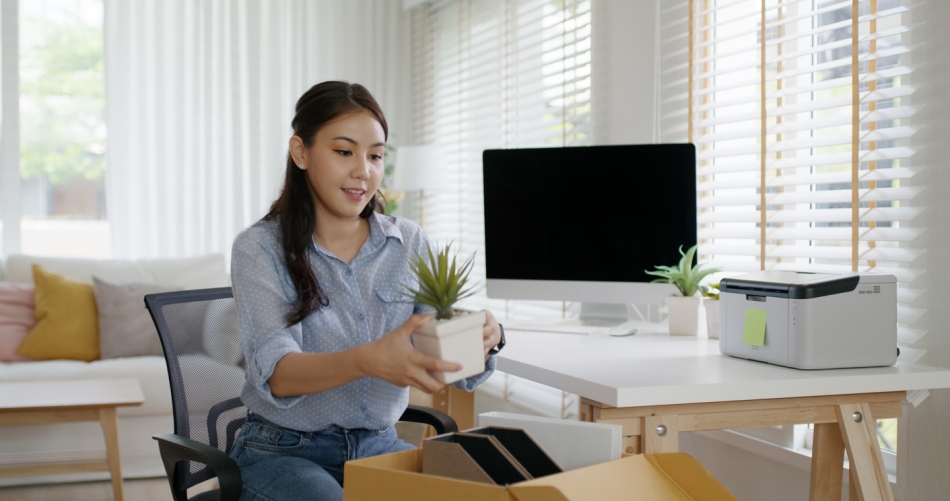Moving a home office can be daunting and can include challenges beyond standard residential moves. Every detail requires attention, from safely transporting sensitive documents and delicate office equipment to organizing cables and electronics. Proper planning is essential to prevent downtime, protect valuable assets, and ensure a smooth transition. Here, we’ll cover top strategies for moving a home office, including step-by-step planning, packing tips, and post-move setup advice to help you stay organized and efficient throughout the process. If you’re looking for broader advice to streamline your relocation, explore these moving tips to make your relocation easier.
How do I relocate an office?
Start by assessing what needs to be moved and creating a home office relocation checklist to stay organized. This list should include furniture, equipment, files, and any fragile items that need special care. Professional moving services can simplify the process for remote workers, especially when relocating heavy or delicate office equipment.
Tip: Start early with an inventory check. Knowing what needs to be moved helps you plan for packing supplies and specialized equipment.
Obtaining moving quotes earlier helps you budget and choose reliable movers. For moves that are further away or across the country, you may want professional assistance protecting office supplies during a move.
What are the risks when moving a home office?
Relocating a home office comes with several risks that can impact productivity and lead to potential losses. One major concern is data loss, which can occur if important files or electronics are damaged during the move. To mitigate this, back up all essential data to cloud storage or an external drive before the move.
Tip: Back up digital files at least two days before your move to ensure you have the most recent versions.
Damaged office equipment is another potential issue. When packing fragile office equipment, use bubble wrap and sturdy boxes to help protect valuable items. Labeling boxes clearly and securing loose parts also can prevent mishaps. Keep sensitive papers in a container that travels with you rather than with the main moving shipment.
Tip: Keep critical documents within arm’s reach. This can prevent misplacement and make access easier during unpacking.
Consider wrapping smaller items in protective layers to further protect your office supplies and grouping them in clearly marked containers. For larger, delicate equipment, consult with professional movers who specialize in safely handling office items.
How to pack a home office for moving
 Organizing cables and electronics: Label all cables with tags or color-coded tape for easy reassembly. Secure them with Velcro straps and pack in labeled bags. Wrap electronics in anti-static bubble wrap and place them in sturdy, cushioned boxes.
Organizing cables and electronics: Label all cables with tags or color-coded tape for easy reassembly. Secure them with Velcro straps and pack in labeled bags. Wrap electronics in anti-static bubble wrap and place them in sturdy, cushioned boxes.
Tip: Snap a photo of cable setups before unplugging them. It makes reassembly easier and faster.
Moving important documents and files safely: Categorize documents in folders and pack essential ones in a waterproof, fireproof container to keep with you. Back up digital files to cloud storage or an external drive.
Packing fragile items: Wrap monitors, printers, and electronics in bubble wrap and pack in cushioned boxes. Use moving containers for extra protection, seal them with packing tape, and mark them as “Fragile.”
Moving office equipment safely
Secure office equipment using the right wrappings, boxes, and tape. Use moving blankets, straps, and packing tape to keep items stable and reduce movement during transport. Specialty tools like furniture dollies and corner protectors can further ensure that equipment arrives safely and intact.
Tip: Use corner protectors to safeguard delicate furniture edges during transport.
Setting up a home office after moving
After your move, setting up your home office is key to resuming work quickly. Start by arranging essential furniture like your desk, chair, and storage units in a layout that supports comfort and productivity. Position your desk near power outlets and windows for optimal lighting and easy access to electricity. Ensure your chair and desk are adjusted ergonomically to promote good posture during long work hours.
Organizing and setting up electronics: Begin by unpacking and setting up essential electronics like your computer, monitors, and printers. Use the labeled cables and organizers from your move to reconnect everything smoothly. Double-check connections and ensure all devices function correctly before moving to less critical items.
Tip: Unpack and set up your computer first to quickly regain internet access and functionality.
Unpacking sensitive documents and equipment: Unpack important documents early and place them in a secure filing system or lockable cabinet. Inspect each piece of office equipment for any signs of damage and test it to ensure it’s working correctly. If you notice any issues, address repairs or replacements promptly to avoid work delays.
How long does it take to relocate an office?
The time required to relocate a home office depends on its size and the distance involved. Local moves typically take one to three days, while cross-country or interstate moves will take longer. The preparation phase—such as packing and organizing—can add several days, especially if you don’t have professional help.
Tips to minimize downtime:
- Plan and pack early: Start packing non-essential items weeks ahead to reduce last-minute stress.
- Prepare a priority setup box: Pack essentials like your computer, chargers, and basic office supplies separately to quickly set up a temporary workspace.
- Coordinate utilities and internet: Ensure services are set up and active at the new location before moving day to avoid delays.
- Hire professional movers: Using movers experienced in handling electronics and office furniture can expedite the process.
These strategies will help you transition smoothly and resume work with minimal interruptions.
Tip: Double-check your unpacking schedule to prioritize what you need first for a smoother setup.
Conclusion
Relocating a home office can be complex, but the process becomes more manageable with thorough planning and strategic packing. You can reduce the risk of damage and stress by creating a detailed checklist, organizing and securing important equipment, and using proper packing techniques. Leveraging professional movers can simplify the move, especially for larger or long-distance relocations, ensuring your valuable items are handled carefully.


